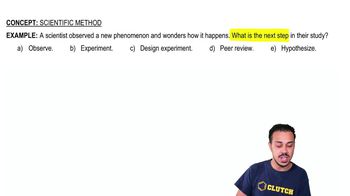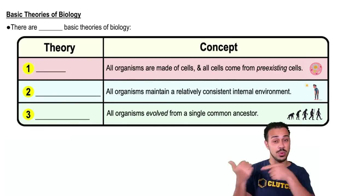Table of contents
- 1. Introduction to Biology2h 42m
- 2. Chemistry3h 40m
- 3. Water1h 26m
- 4. Biomolecules2h 23m
- 5. Cell Components2h 26m
- 6. The Membrane2h 31m
- 7. Energy and Metabolism2h 0m
- 8. Respiration2h 40m
- 9. Photosynthesis2h 49m
- 10. Cell Signaling59m
- 11. Cell Division2h 47m
- 12. Meiosis2h 0m
- 13. Mendelian Genetics4h 44m
- Introduction to Mendel's Experiments7m
- Genotype vs. Phenotype17m
- Punnett Squares13m
- Mendel's Experiments26m
- Mendel's Laws18m
- Monohybrid Crosses19m
- Test Crosses14m
- Dihybrid Crosses20m
- Punnett Square Probability26m
- Incomplete Dominance vs. Codominance20m
- Epistasis7m
- Non-Mendelian Genetics12m
- Pedigrees6m
- Autosomal Inheritance21m
- Sex-Linked Inheritance43m
- X-Inactivation9m
- 14. DNA Synthesis2h 27m
- 15. Gene Expression3h 20m
- 16. Regulation of Expression3h 31m
- Introduction to Regulation of Gene Expression13m
- Prokaryotic Gene Regulation via Operons27m
- The Lac Operon21m
- Glucose's Impact on Lac Operon25m
- The Trp Operon20m
- Review of the Lac Operon & Trp Operon11m
- Introduction to Eukaryotic Gene Regulation9m
- Eukaryotic Chromatin Modifications16m
- Eukaryotic Transcriptional Control22m
- Eukaryotic Post-Transcriptional Regulation28m
- Eukaryotic Post-Translational Regulation13m
- 17. Viruses37m
- 18. Biotechnology2h 58m
- 19. Genomics17m
- 20. Development1h 5m
- 21. Evolution3h 1m
- 22. Evolution of Populations3h 52m
- 23. Speciation1h 37m
- 24. History of Life on Earth2h 6m
- 25. Phylogeny2h 31m
- 26. Prokaryotes4h 59m
- 27. Protists1h 12m
- 28. Plants1h 22m
- 29. Fungi36m
- 30. Overview of Animals34m
- 31. Invertebrates1h 2m
- 32. Vertebrates50m
- 33. Plant Anatomy1h 3m
- 34. Vascular Plant Transport1h 2m
- 35. Soil37m
- 36. Plant Reproduction47m
- 37. Plant Sensation and Response1h 9m
- 38. Animal Form and Function1h 19m
- 39. Digestive System1h 10m
- 40. Circulatory System1h 57m
- 41. Immune System1h 12m
- 42. Osmoregulation and Excretion50m
- 43. Endocrine System1h 4m
- 44. Animal Reproduction1h 2m
- 45. Nervous System1h 55m
- 46. Sensory Systems46m
- 47. Muscle Systems23m
- 48. Ecology3h 11m
- Introduction to Ecology20m
- Biogeography14m
- Earth's Climate Patterns50m
- Introduction to Terrestrial Biomes10m
- Terrestrial Biomes: Near Equator13m
- Terrestrial Biomes: Temperate Regions10m
- Terrestrial Biomes: Northern Regions15m
- Introduction to Aquatic Biomes27m
- Freshwater Aquatic Biomes14m
- Marine Aquatic Biomes13m
- 49. Animal Behavior28m
- 50. Population Ecology3h 41m
- Introduction to Population Ecology28m
- Population Sampling Methods23m
- Life History12m
- Population Demography17m
- Factors Limiting Population Growth14m
- Introduction to Population Growth Models22m
- Linear Population Growth6m
- Exponential Population Growth29m
- Logistic Population Growth32m
- r/K Selection10m
- The Human Population22m
- 51. Community Ecology2h 46m
- Introduction to Community Ecology2m
- Introduction to Community Interactions9m
- Community Interactions: Competition (-/-)38m
- Community Interactions: Exploitation (+/-)23m
- Community Interactions: Mutualism (+/+) & Commensalism (+/0)9m
- Community Structure35m
- Community Dynamics26m
- Geographic Impact on Communities21m
- 52. Ecosystems2h 36m
- 53. Conservation Biology24m
1. Introduction to Biology
Scientific Method
Problem 2`
Textbook Question
Which of the following is an example of inductive reasoning?
a. All cows eat grass.
b. My cow eats grass and my neighbor's cow eats grass; therefore, all cows probably eat grass.
c. If all cows eat grass, when I examine a random sample of all the cows in Minnesota, I will find that all of them eat grass.
d. Cows may or may not eat grass, depending on the type of farm where they live.
 Verified step by step guidance
Verified step by step guidance1
Step 1: Understand the concept of inductive reasoning. Inductive reasoning involves making generalizations based on specific observations or evidence. It starts with specific instances and moves toward a broader generalization or conclusion.
Step 2: Analyze each option to determine if it fits the definition of inductive reasoning. Look for a statement that begins with specific observations and concludes with a generalization.
Step 3: Evaluate option (a): 'All cows eat grass.' This is a general statement and does not involve reasoning from specific observations, so it is not an example of inductive reasoning.
Step 4: Evaluate option (b): 'My cow eats grass and my neighbor's cow eats grass; therefore, all cows probably eat grass.' This starts with specific observations (my cow and my neighbor's cow eating grass) and concludes with a generalization (all cows probably eat grass). This fits the definition of inductive reasoning.
Step 5: Evaluate options (c) and (d): Option (c) involves deductive reasoning, as it starts with a general statement and predicts specific outcomes. Option (d) is a conditional statement and does not involve reasoning from specific observations. Therefore, option (b) is the correct example of inductive reasoning.
 Verified video answer for a similar problem:
Verified video answer for a similar problem:This video solution was recommended by our tutors as helpful for the problem above
Video duration:
1mPlay a video:
Was this helpful?
Key Concepts
Here are the essential concepts you must grasp in order to answer the question correctly.
Inductive Reasoning
Inductive reasoning is a logical process in which generalizations are made based on specific observations or examples. It involves drawing conclusions from patterns or trends observed in data, leading to broader generalizations. For instance, if several individual cows are observed eating grass, one might conclude that all cows likely eat grass, even though this conclusion is not guaranteed.
Recommended video:
Guided course

Introduction to Bacterial Plasmids
Deductive Reasoning
Deductive reasoning is the process of drawing specific conclusions from general principles or premises. It starts with a general statement or hypothesis and examines the possibilities to reach a specific, logical conclusion. For example, if it is stated that all cows eat grass, then observing a cow would lead to the conclusion that this particular cow eats grass, assuming the initial premise is true.
Recommended video:
Guided course

The Human Population Example 1
Sample and Generalization
In statistics and reasoning, a sample refers to a subset of a population used to make inferences about the whole. Generalization occurs when conclusions drawn from a sample are applied to the entire population. This process is central to inductive reasoning, as it relies on the assumption that the observed characteristics of the sample can be extended to the broader group, which can sometimes lead to inaccuracies if the sample is not representative.
Recommended video:
Guided course

Sampling Stationary Organisms: Transects & Quadrats
Related Videos
Related Practice














